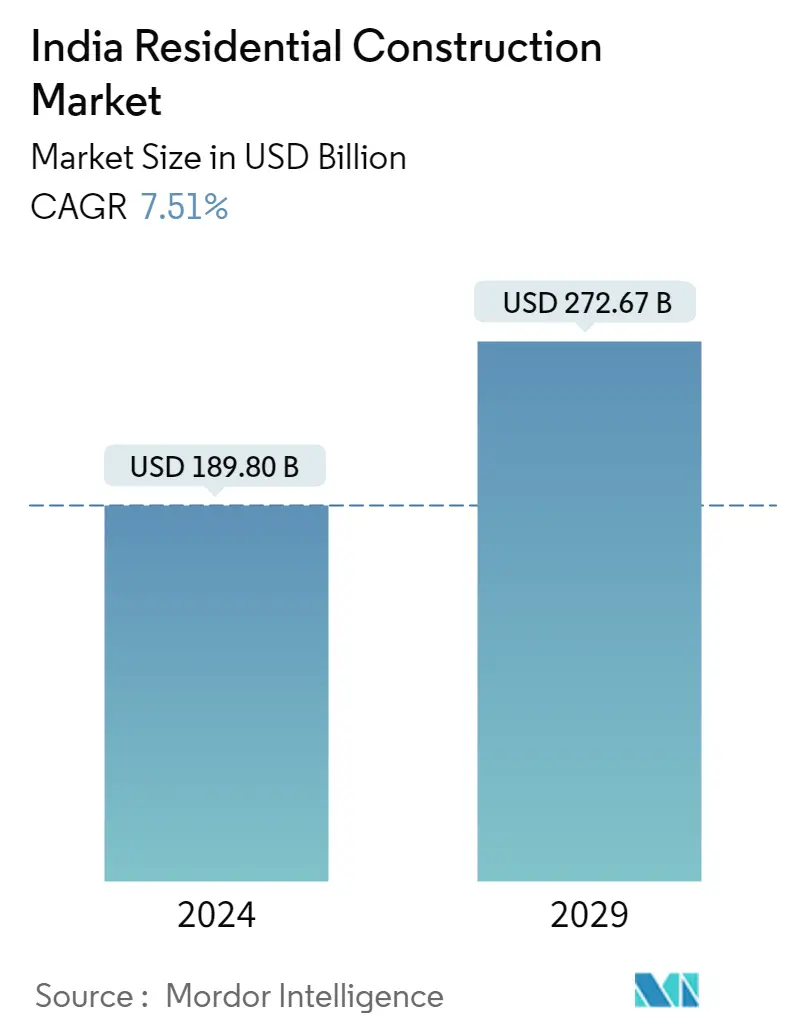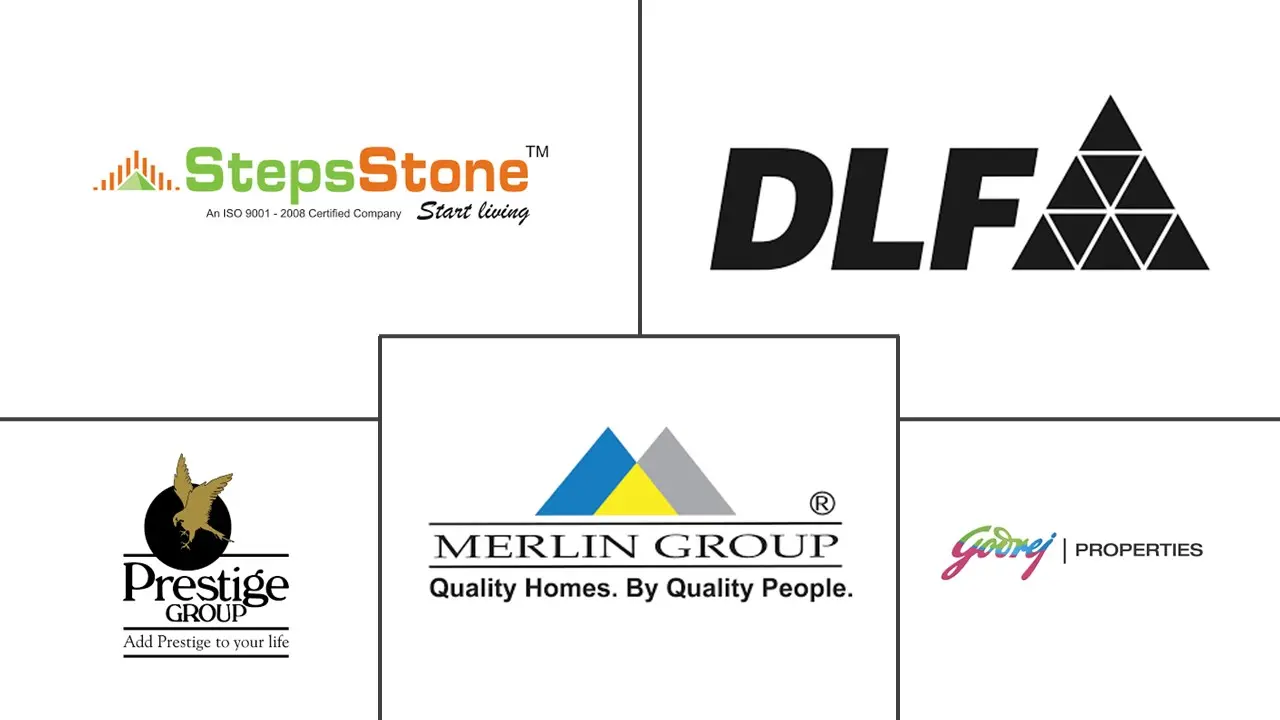Market Size of India Residential Construction Industry

| Study Period | 2019 - 2029 |
| Base Year For Estimation | 2023 |
| Market Size (2024) | USD 189.80 Billion |
| Market Size (2029) | USD 272.67 Billion |
| CAGR (2024 - 2029) | 7.51 % |
| Market Concentration | Low |
Major Players
*Disclaimer: Major Players sorted in no particular order |
India Residential Construction Market Analysis
The India Residential Construction Market size is estimated at USD 189.80 billion in 2024, and is expected to reach USD 272.67 billion by 2029, growing at a CAGR of 7.51% during the forecast period (2024-2029).
The cost of raw materials in India was on the rise, and since the COVID-19 pandemic, the cost kept increasing. A reason behind this increase in the cost of raw materials is the shortage of supply of raw materials because of the disruptive supply chain. Along with these, there has also been the introduction of several taxes by the state governments on these materials that are also contributing to the increasing costs. The scarcity of building materials raises the cost of overall construction, which is projected to hamper the growth of the Indian residential construction market.
The government's flagship initiative, the Pradhan Mantri Awas Yojana (Urban), which was launched in June 2015, aimed to provide housing for all in urban areas. To make the market more accessible to small and retail investors, the Securities and Exchange Board of India has reduced the minimum application value for Real Estate Investment Trusts (REITs) from INR 50,000 (USD 611.14) to INR 10,000-15,000 (USD 122.23-183.34). As a result, home sales volume in seven major Indian cities accelerated by 113% year-on-year in the third quarter of 2021. Private equity investment inflows into India's real estate sector totaled USD 3.3 billion in the first half of FY21-22. The top three cities, Mumbai (39%), Delhi (19%), and Bengaluru (19%), together attracted nearly 77% of the total investments.
Under the Pradhan Mantri Awas Yojana, the Indian government sanctioned the construction of 3.61 lakh homes in November 2021. In addition, with the clearance of the new housing units, 1.14 crore homes have been approved for the program. It is anticipated that the Indian Government's affordable housing program will continue to support the growth of the residential construction sector from a short- to medium-term perspective, which will subsequently aid the growth of India's residential construction industry. The central government is anticipated to approve more housing units under the PMAY scheme over the next four to eight quarters.
India Residential Construction Industry Segmentation
Residential construction is a process that involves the expansion, renovation, or construction of a new home or spaces intended to be occupied for residential purposes. In the residential construction market, buildings are constructed and then sold to customers.
India's residential construction market is segmented by type (apartments and condominiums, villas, and other types) and by construction Type (new construction and renovation).
The report offers the market sizes and forecasts for the Indian residential construction market in value (USD) for all the above segments.
Furthermore, this report covers market insights, such as market dynamics, drivers, restraints, opportunities, technological innovation, its impact, Porter's Five Forces Analysis, and the impact of COVID-19 on the market. In addition, the report also provides company profiles to understand the competitive landscape of the market.
| By Type | |
| Apartments and Condominiums | |
| Villas | |
| Other Types |
| By Construction Type | |
| New Construction | |
| Renovation |
India Residential Construction Market Size Summary
The Indian residential construction market is poised for significant growth over the forecast period, driven by urbanization, rising household incomes, and favorable loan rates. Government initiatives like the Pradhan Mantri Awas Yojana (PMAY) have been pivotal in promoting affordable housing, aiming to provide safe homes for all Indians. The reduction in the minimum application value for Real Estate Investment Trusts (REITs) has made the market more accessible to small and retail investors, further boosting demand. Despite challenges such as rising raw material costs and supply chain disruptions, the market is expected to expand, supported by policy reforms and increased government spending on housing projects.
The competitive landscape of the Indian residential construction market is characterized by a mix of local, regional, and a few global players, with companies like Godrej Properties and Prestige Group leading the charge. These players are actively acquiring land and expanding projects to meet the burgeoning demand for housing. The market has seen a surge in residential property launches, particularly in major cities like Mumbai, Delhi, and Bengaluru, reflecting the strong demand for housing. As urbanization continues to rise, the need for mid-range and affordable housing units is expected to grow, further propelling the market's expansion.
India Residential Construction Market Size - Table of Contents
-
1. MARKET INSIGHTS
-
1.1 Current Market Scenario
-
1.2 Technological Innovations in the Residential Construction Sector
-
1.3 Industry Value Chain/Supply Chain Analysis
-
1.4 Government Initiatives and Regulatory Aspects in the Indian Residential Construction Market
-
1.5 Insights into Rental Yields
-
1.6 Insights into Affordable Housing Support Provided by Government and Public-private Partnerships
-
1.7 Insights into Services allied to Construction (Design and Engineering, Fit-out Services, Facility management, etc.)
-
1.8 Insights into Costs Related to Construction and Building Materials
-
1.9 Impact of COVID-19 on the Market
-
-
2. MARKET SEGMENTATION
-
2.1 By Type
-
2.1.1 Apartments and Condominiums
-
2.1.2 Villas
-
2.1.3 Other Types
-
-
2.2 By Construction Type
-
2.2.1 New Construction
-
2.2.2 Renovation
-
-
India Residential Construction Market Size FAQs
How big is the India Residential Construction Market?
The India Residential Construction Market size is expected to reach USD 189.80 billion in 2024 and grow at a CAGR of 7.51% to reach USD 272.67 billion by 2029.
What is the current India Residential Construction Market size?
In 2024, the India Residential Construction Market size is expected to reach USD 189.80 billion.

